Plasma Modification of Biomass-Based Starfish Catalysts for Efficient Biodiesel Synthesis
Abstract
:1. Introduction
2. Experimental Section
2.1. Materials
2.2. Preparation of Catalyst
2.3. Biodiesel Production via Transesterification
2.4. Catalyst Characterization
2.5. Catalytic Performance Test
3. Results and Discussion
3.1. Morphology and Textural Properties
3.2. Structural and Chemical Properties
3.3. Catalytic Performance
4. Conclusions
Supplementary Materials
Author Contributions
Funding
Data Availability Statement
Conflicts of Interest
References
- Dias, C.N.; Viana, A.M.; Cunha-Silva, L.; Balula, S.S. The Role of the Heterogeneous Catalyst to Produce Solketal from Biodiesel Waste: The Key to Achieve Efficiency. Nanomaterials 2024, 14, 828. [Google Scholar] [CrossRef]
- Akram, F.; ul Haq, I.; Raja, S.I.; Mir, A.S.; Qureshi, S.S.; Aqeel, A.; Shah, F.I. Current trends in biodiesel production technologies and future progressions: A possible displacement of the petro-diesel. J. Clean. Prod. 2022, 370, 133479. [Google Scholar] [CrossRef]
- Fadhil, A.B.; Al-Tikrity, E.T.B.; Khalaf, A.M. Transesterification of non-edible oils over potassium acetate impregnated CaO solid base catalyst. Fuel 2018, 234, 81–93. [Google Scholar] [CrossRef]
- Donoso, D.; Bolonio, D.; Lapuerta, M.; Canoira, L. Oxidation stability: The bottleneck for the development of a fully renewable biofuel from wine industry waste. ACS Omega 2020, 5, 16645–16653. [Google Scholar] [CrossRef]
- Venkatesan, H.; Sivamani, S. Evaluating the predicting capability of response surface methodology on biodiesel production from grape seed bio-oil. Energy Sources Part A Recovery Util. Environ. Eff. 2022, 44, 2473–2488. [Google Scholar] [CrossRef]
- Yu, J.; Smith, I.; Carver, J.; Holmes, B. Fatty Acid Composition of Grape Seed Oil as Affected by Grape Variety and Extraction Solvent. EC Nutr. 2021, 16, 51–58. [Google Scholar]
- Di Serio, M.; Tesser, R.; Pengmei, L.; Santacesaria, E. Heterogeneous catalysts for biodiesel production. Energy Fuel 2008, 22, 207–217. [Google Scholar] [CrossRef]
- Ma, F.R.; Hanna, M.A. Biodiesel production: A review. Bioresour. Technol. 1999, 70, 1–15. [Google Scholar] [CrossRef]
- Sakai, T.; Kawashima, A.; Koshikawa, T. Economic assessment of batch biodiesel production processes using homogeneous and heterogeneous alkali catalysts. Bioresour. Technol. 2009, 100, 3268–3276. [Google Scholar] [CrossRef]
- Widayat, W.; Darmawan, T.; Hadiyanto, H.; Rosyid, R.A. Preparation of heterogeneous CaO catalysts for biodiesel production. J. Phys. Conf. Ser. 2017, 877, 012018. [Google Scholar] [CrossRef]
- Weldeslase, M.G.; Benti, N.E.; Desta, M.A.; Mekonnen, Y.S. Maximizing biodiesel production from waste cooking oil with lime-based zinc-doped CaO using response surface methodology. Sci. Rep. 2023, 13, 4430. [Google Scholar] [CrossRef]
- Boey, P.L.; Maniam, G.P.; Abd Hamid, S. Performance of calcium oxide as a heterogeneous catalyst in biodiesel production: A review. Chem. Eng. J. 2011, 168, 15–22. [Google Scholar] [CrossRef]
- Liu, X.J.; He, H.Y.; Wang, Y.J.; Zhu, S.L.; Piao, X.L. Transesterification of soybean oil to biodiesel using CaO as a solid base catalyst. Fuel 2008, 87, 216–221. [Google Scholar] [CrossRef]
- Lam, M.K.; Lee, K.T.; Mohamed, A.R. Homogeneous, heterogeneous and enzymatic catalysis for transesterification of high free fatty acid oil (waste cooking oil) to biodiesel: A review. Biotechnol. Adv. 2010, 28, 500–518. [Google Scholar] [CrossRef] [PubMed]
- Kouzu, M.; Kasuno, T.; Tajika, M.; Sugimoto, Y.; Yamanaka, S.; Hidaka, J. Calcium oxide as a solid base catalyst for transesterification of soybean oil and its application to biodiesel production. Fuel 2008, 87, 2798–2806. [Google Scholar] [CrossRef]
- Viriya-Empikul, N.; Krasae, P.; Puttasawat, B.; Yoosuk, B.; Chollacoop, N.; Faungnawakij, K. Waste shells of mollusk and egg as biodiesel production catalysts. Bioresour. Technol. 2010, 101, 3765–3767. [Google Scholar] [CrossRef]
- Boey, P.L.; Maniam, G.P.; Abd Hamid, S. Biodiesel production via transesterification of palm olein using waste mud crab (Scylla serrata) shell as a heterogeneous catalyst. Bioresour. Technol. 2009, 100, 6362–6368. [Google Scholar] [CrossRef] [PubMed]
- Jo, Y.B.; Park, S.H.; Jeon, J.K.; Ko, C.H.; Ryu, C.; Park, Y.K. Biodiesel Production via the Transesterification of Soybean Oil Using Waste Starfish (Asterina pectinifera). Appl. Biochem. Biotech. 2013, 170, 1426–1436. [Google Scholar] [CrossRef] [PubMed]
- Kim, Y.; Jung, S.; Park, Y.-K.; Moon, D.H.; Kwon, E.E. Exploiting starfish in pyrolysis for the enhanced generation of syngas and CO2-looping agent. J. Clean. Prod. 2020, 276, 123228. [Google Scholar] [CrossRef]
- Brügmann, L.; Lange, D. Trace metal studies on the starfish Asterias rubens L. from the western Baltic Sea. Chem. Ecol. 1988, 3, 295–311. [Google Scholar] [CrossRef]
- Verziu, M.; Cojocaru, B.; Hu, J.C.; Richards, R.; Ciuculescu, C.; Filip, P.; Parvulescu, V.I. Sunflower and rapeseed oil transesterification to biodiesel over different nanocrystalline MgO catalysts. Green Chem. 2008, 10, 373–381. [Google Scholar] [CrossRef]
- Granados, M.L.; Alonso, D.M.; Sádaba, I.; Mariscal, R.; Ocón, P. Leaching and homogeneous contribution in liquid phase reaction catalysed by solids: The case of triglycerides methanolysis using CaO. Appl. Catal. B-Environ. 2009, 89, 265–272. [Google Scholar] [CrossRef]
- Chen, G.Y.; Shan, R.; Li, S.Y.; Shi, J.F. A biomimetic silicification approach to synthesize CaO-SiO2 catalyst for the transesterification of palm oil into biodiesel. Fuel 2015, 153, 48–55. [Google Scholar] [CrossRef]
- Thitsartarn, W.; Kawi, S. An active and stable CaO-CeO2 catalyst for transesterification of oil to biodiesel. Green Chem. 2011, 13, 3423–3430. [Google Scholar] [CrossRef]
- Dai, Y.M.; Li, Y.Y.; Lin, J.H.; Kao, I.H.; Lin, Y.J.; Chen, C.C. Applications of M2ZrO2 (M = Li, Na, K) composite as a catalyst for biodiesel production. Fuel 2021, 286, 119392. [Google Scholar] [CrossRef]
- Bournay, L.; Casanave, D.; Delfort, B.; Hillion, G.; Chodorge, J.A. New heterogeneous process for biodiesel production: A way to improve the quality and the value of the crude glycerin produced by biodiesel plants. Catal. Today 2005, 106, 190–192. [Google Scholar] [CrossRef]
- Tamaddon, F.; Amrollahi, M.A.; Sharafat, L. A green protocol for chemoselective O-acylation in the presence of zinc oxide as a heterogeneous, reusable and eco-friendly catalyst. Tetrahedron Lett. 2005, 46, 7841–7844. [Google Scholar] [CrossRef]
- Alba-Rubio, A.C.; Santamaría-González, J.; Mérida-Robles, J.M.; Moreno-Tost, R.; Martín-Alonso, D.; Jiménez-López, A.; Maireles-Torres, P. Heterogeneous transesterification processes by using CaO supported on zinc oxide as basic catalysts. Catal. Today 2010, 149, 281–287. [Google Scholar] [CrossRef]
- Kumar, D.; Ali, A. Transesterification of Low-Quality Triglycerides over a Zn/CaO Heterogeneous Catalyst: Kinetics and Reusability Studies. Energy Fuel 2013, 27, 3758–3768. [Google Scholar] [CrossRef]
- Arenas-Quevedo, M.G.; Manríquez, M.E.; Wang, J.A.; Elizalde-Solís, O.; Gonzalez-Garcia, J.; Zúñiga-Moreno, A.; Chen, L.F. ZnO-Doped CaO Binary Core-Shell Catalysts for Biodiesel Production via Mexican Palm Oil Transesterification. Inorganics 2024, 12, 51. [Google Scholar] [CrossRef]
- Hlaing, N.N.; Othman, R.; Hinode, H.; Kurniawan, W.; Thant, A.A.; Mohamed, A.R.; Salim, C.; Sreekantan, S. The Influence of Hydrothermal Temperature on CaO-based Adsorbents Synthesized by Sol-Gel-Hydrothermal Method. Procedia Environ. Sci. 2014, 20, 71–78. [Google Scholar] [CrossRef]
- Liu, F.; Zhang, Y. Hydrothermal growth of flower-like CaO for biodiesel production. Ceram. Int. 2012, 38, 3473–3482. [Google Scholar] [CrossRef]
- Kim, S.; Ji, S.; Jeong, S.; Yang, H.; Lee, S.; Choi, H.; Li, O.L. Switching Electric Double Layer Potential by Phase Structure Control for Advanced Oxygen Reduction Reaction of Cobalt@Nitrogen Doped Carbon Core-Shell. Small 2024, 20, 2307483. [Google Scholar] [CrossRef]
- Lee, S.; Kim, S.; Lee, J.H.; Choi, H.; Takeuchi, N.; Li, O.L. Plasma surface modification of single-atom Fe active sites on nano-sized graphene platelets for advanced oxygen reduction reaction. IJPEST 2022, 16, e03002. [Google Scholar] [CrossRef]
- Kim, S.; Yang, H.Y.S.; Jeong, S.; Lee, T.W.; Chae, S.; Lee, J.H.; Li, O.L. Negative surface charge-mediated Fe Quantum dots with N-doped graphene/Ti3C2Tx MXene as chlorine-resistance electrocatalysts for high performance seawater-based Al-air batteries. J. Power Sources 2023, 566, 232923. [Google Scholar] [CrossRef]
- Zhang, Y.; Niu, S.; Han, K.; Li, Y.; Lu, C. Synthesis of the SrO–CaO–Al2O3 trimetallic oxide catalyst for transesterification to produce biodiesel. Renew. Energy 2021, 168, 981–990. [Google Scholar] [CrossRef]
- Fasanya, O.O.; Gbadamasi, S.; Osigbesan, A.A.; Ahmed, O.U.; Isa, A.R.; Ozogu, A.N.; Hayatudeen, A.; Yusuf, A.I.; Gano, Z.S. Effect of Hydrothermal Treatment on the Properties of Calcium Oxide from Eggshells Used as a Biodiesel Catalyst. Chem. Eng. Technol. 2022, 45, 283–290. [Google Scholar] [CrossRef]
- FoodsafetyKorea, Grapeseed Oil Nutrition Detail. Available online: https://various.foodsafetykorea.go.kr/nutrient/general/food/detail.do?dbGrpCm=A&searchTextPre=&searchTextListStr=&sortOrder=DESC&sortFieldCnt=1&searchProcCode=LOG_IDX&searchLogType=main&searchSubOrderby=&searchDetailMode=all&searchGroup=&searchCrtMth=1&searchMaker=&searchSource=&searchClass=&searchQc=&searchHcln=&searchReduct=&searchText=%ED%8F%AC%EB%8F%84%EC%94%A8%EC%9C%A0&searchOper=AND&searchGroupText=&searchMakerText=&searchOrderby=CAL&searchPageCnt=10&pagenum=1&totalListCnt=1&pageblock=10&pagesize=10&searchFoodCd=R114-026000000-0000&searchRegionCd=ZZ&searchMonthCd=AVG (accessed on 29 June 2024).
- He, H.Y.; Wang, T.; Zhu, S.L. Continuous production of biodiesel fuel from vegetable oil using supercritical methanol process. Fuel 2007, 86, 442–447. [Google Scholar] [CrossRef]
- Lani, N.S.; Ngadi, N.; Yahya, N.Y.; Abd Rahman, R. Synthesis, characterization and performance of silica impregnated calcium oxide as heterogeneous catalyst in biodiesel production. J. Clean. Prod. 2017, 146, 116–124. [Google Scholar] [CrossRef]
- Xavier, C.S.; Sczancoski, J.C.; Cavalcante, L.S.; Paiva-Santos, C.O.; Varela, J.A.; Longo, E.; Li, M.S. A new processing method of CaZn2(OH)6· 2H2O powders: Photoluminescence and growth mechanism. Solid State Sci. 2009, 11, 2173–2179. [Google Scholar] [CrossRef]
- Chokradjaroen, C.; Wang, X.; Niu, J.; Fan, T.; Saito, N. Fundamentals of solution plasma for advanced materials synthesis. Mater. Today Adv. 2022, 14, 100244. [Google Scholar] [CrossRef]
- Zhang, Q.-H.; Li, S.-P.; Sun, S.-Y.; Yin, X.-S.; Yu, J.-G. LiMn2O4 spinel direct synthesis and lithium ion selective adsorption. Chem. Eng. Sci. 2010, 65, 169–173. [Google Scholar] [CrossRef]
- Subha, T.; Yogeswari, M.; Abarna, B. Impact of alkaline-earth metals (Ca and Mg) on structural, optical, antibacterial and photocatalytic properties of ZnO nanoparticles. MRS Adv. 2022, 7, 450–455. [Google Scholar] [CrossRef]
- Khan, A.; Wei, D.L.; Khuda, F.; Ma, R.; Ismail, M.; Ai, Y.J. Comparative adsorption capabilities of rubbish tissue paper-derived carbon-doped MgO and CaCO3 for EBT and U(VI), studied by batch, spectroscopy and DFT calculations. Environ. Sci. Pollut. Res. 2020, 27, 13114–13130. [Google Scholar] [CrossRef] [PubMed]
- Wan, Y.; Samundsett, C.; Bullock, J.; Hettick, M.; Allen, T.; Yan, D.; Peng, J.; Wu, Y.; Cui, J.; Javey, A. Conductive and stable magnesium oxide electron-selective contacts for efficient silicon solar cells. Adv. Energy Mater. 2017, 7, 1601863. [Google Scholar] [CrossRef]
- Demri, B.; Muster, D. XPS study of some calcium compounds. J. Mater. Process. Technol. 1995, 55, 311–314. [Google Scholar] [CrossRef]
- Ardizzone, S.; Bianchi, C.L.; Fadoni, M.; Vercelli, B. Magnesium salts and oxide: An XPS overview. Appl. Surf. Sci. 1997, 119, 253–259. [Google Scholar] [CrossRef]
- Luo, H.Y.; Liu, Y.; Lu, H.X.; Fang, Q.; Rong, H.W. Efficient Adsorption of Tetracycline from Aqueous Solutions by Modified Alginate Beads after the Removal of Cu(II) Ions. Acs Omega 2021, 6, 6240–6251. [Google Scholar] [CrossRef] [PubMed]
- Radoń, A.; Hawełek, Ł.; Łukowiec, D.; Kubacki, J.; Włodarczyk, P. Dielectric and electromagnetic interference shielding properties of high entropy (Zn, Fe, Ni, Mg, Cd) Fe2O4 ferrite. Sci. Rep. 2019, 9, 20078. [Google Scholar] [CrossRef]
- Tanabe, K.; Yamaguchi, T. Measurement of acidity and basicity of silica-alumina and acidity of zinc sulfide by calorimetric titration. J. Res. Inst. Catal. Hokkaido Univ. 1966, 14, 93–100. Available online: http://hdl.handle.net/2115/24809 (accessed on 1 June 2024).
- Moritsuka, M.; Kitasako, Y.; Burrow, M.F.; Ikeda, M.; Tagami, J. The pH change after HCl titration into resting and stimulated saliva for a buffering capacity test. Aust. Dent. J. 2006, 51, 170–174. [Google Scholar] [CrossRef] [PubMed]
- Rivet, Q.; Beucher, R.; Morfin, F.; Nardin, T.; Farrusseng, D. Quantification of relevant Brønsted acid sites on Cl-doped alumina catalysts for the isomerization of olefins. J. Catal. 2023, 427, 115088. [Google Scholar] [CrossRef]
- Hu, S.Y.; Wang, Y.; Han, H.Y. Utilization of waste freshwater mussel shell as an economic catalyst for biodiesel production. Biomass Bioenergy 2011, 35, 3627–3635. [Google Scholar] [CrossRef]
- Wang, A.; Quan, W.; Zhang, H.; Li, H.; Yang, S. Heterogeneous ZnO-containing catalysts for efficient biodiesel production. Rsc Adv. 2021, 11, 20465–20478. [Google Scholar] [CrossRef] [PubMed]
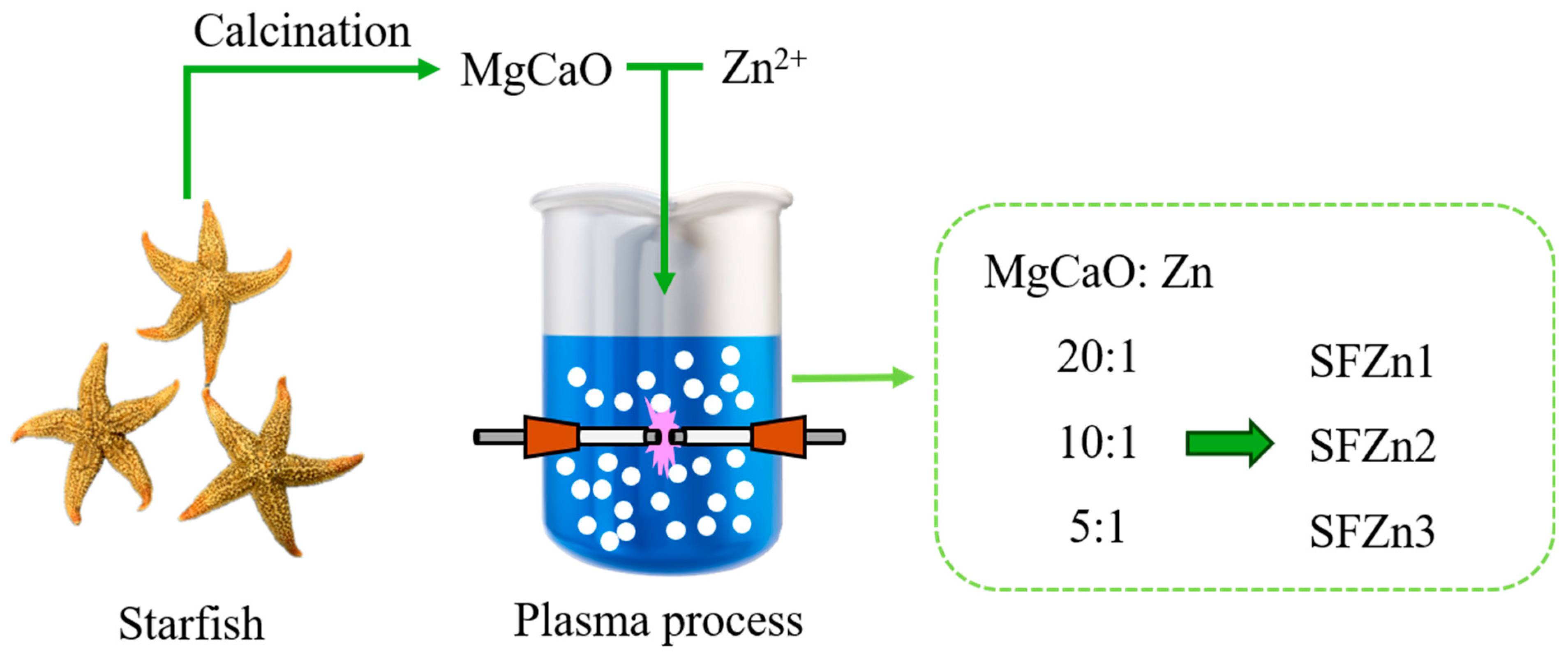
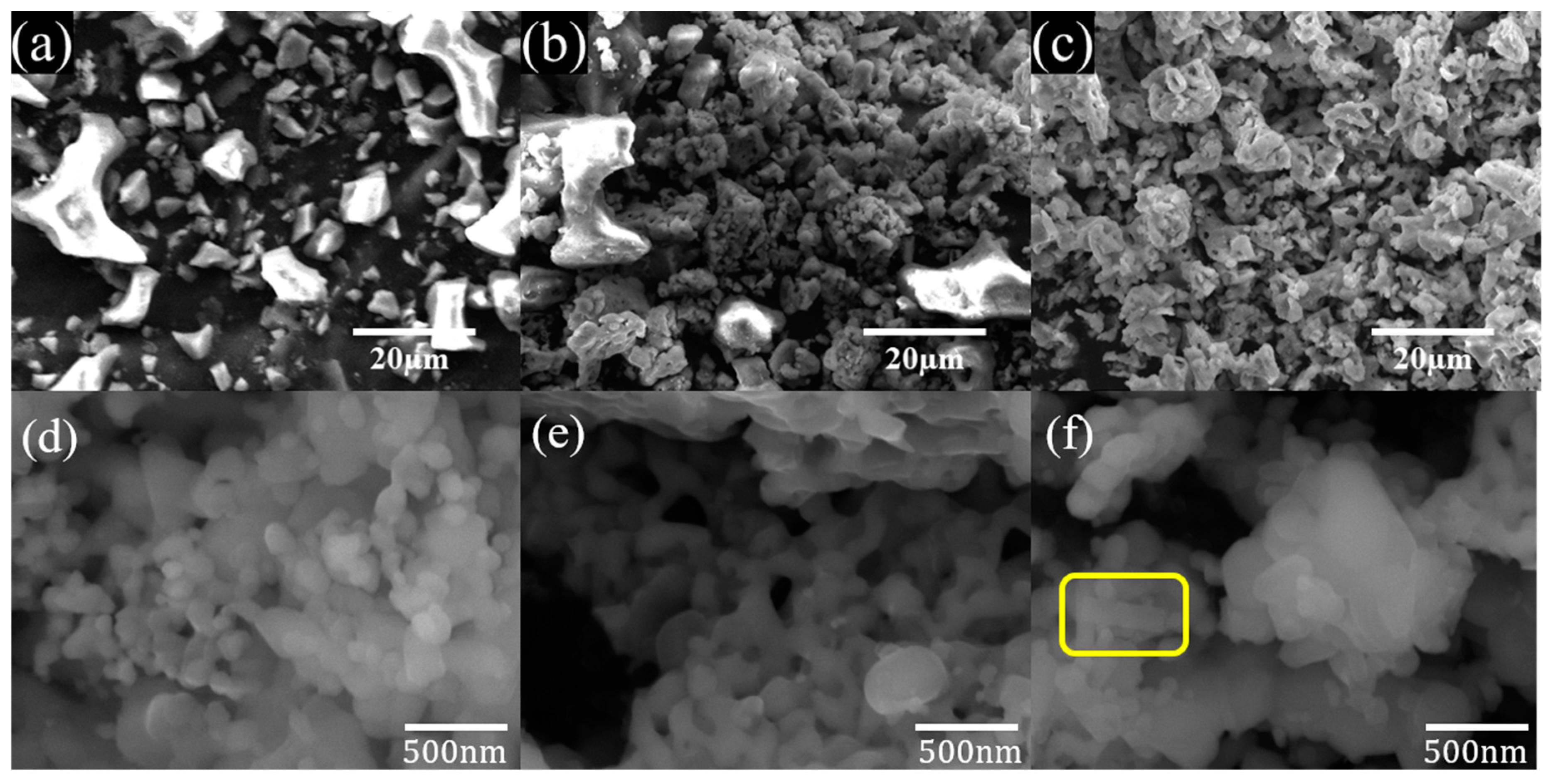


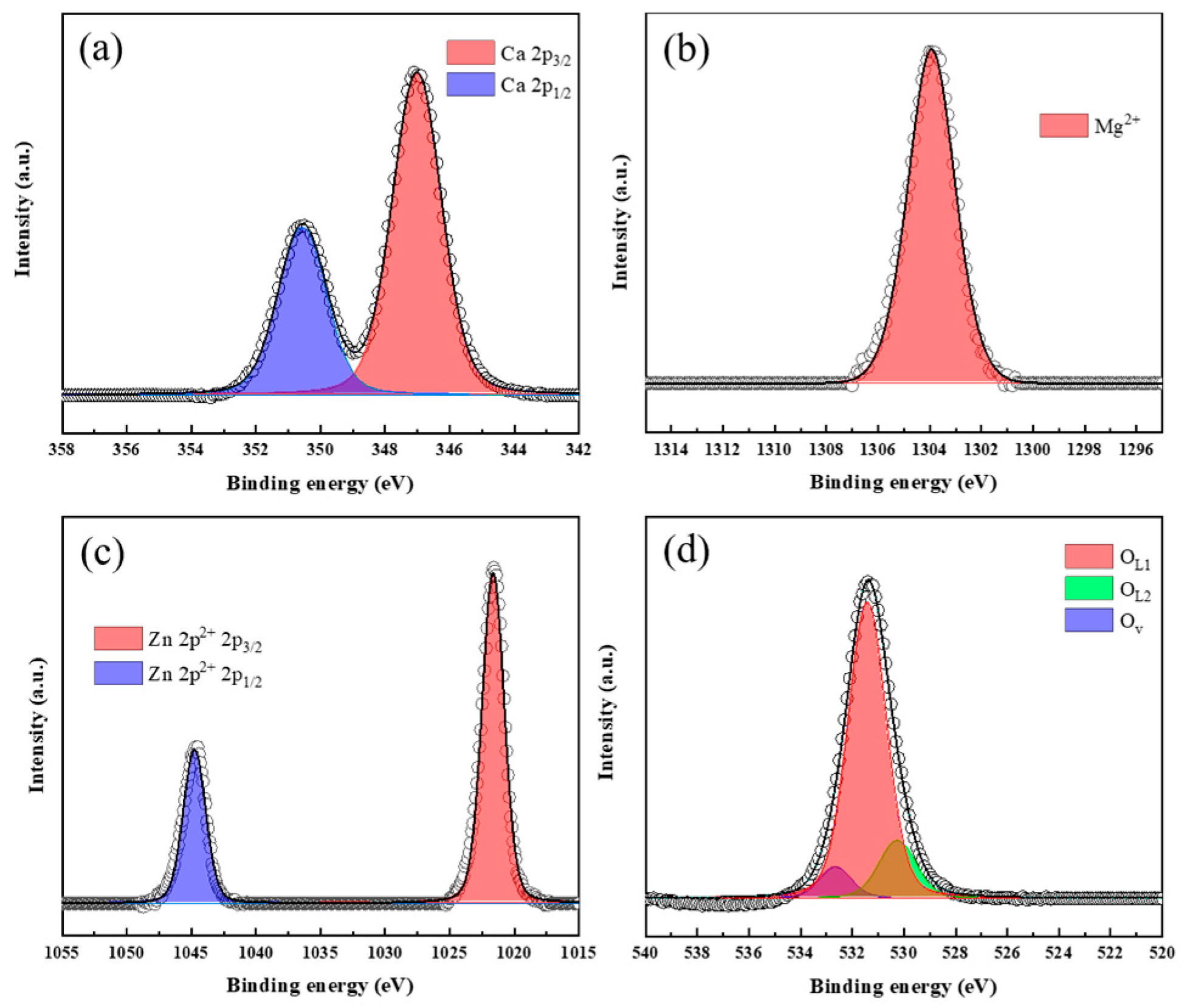
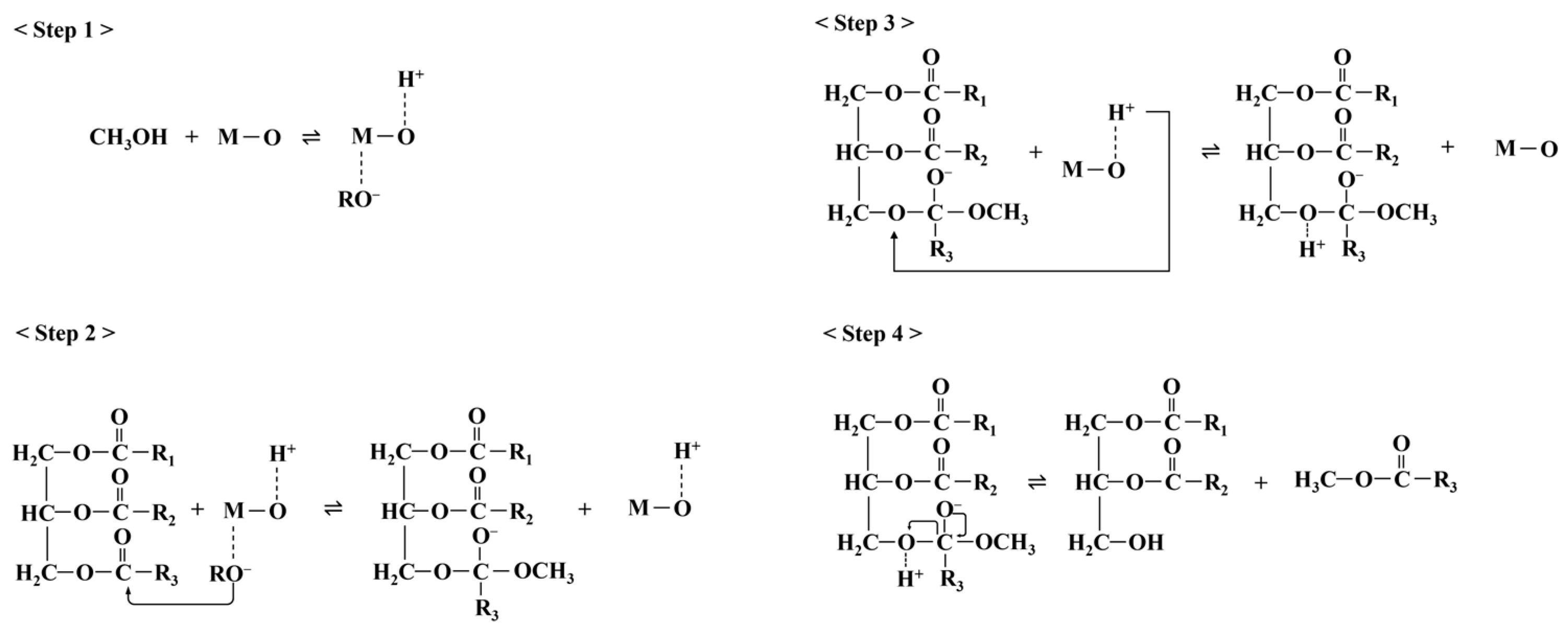
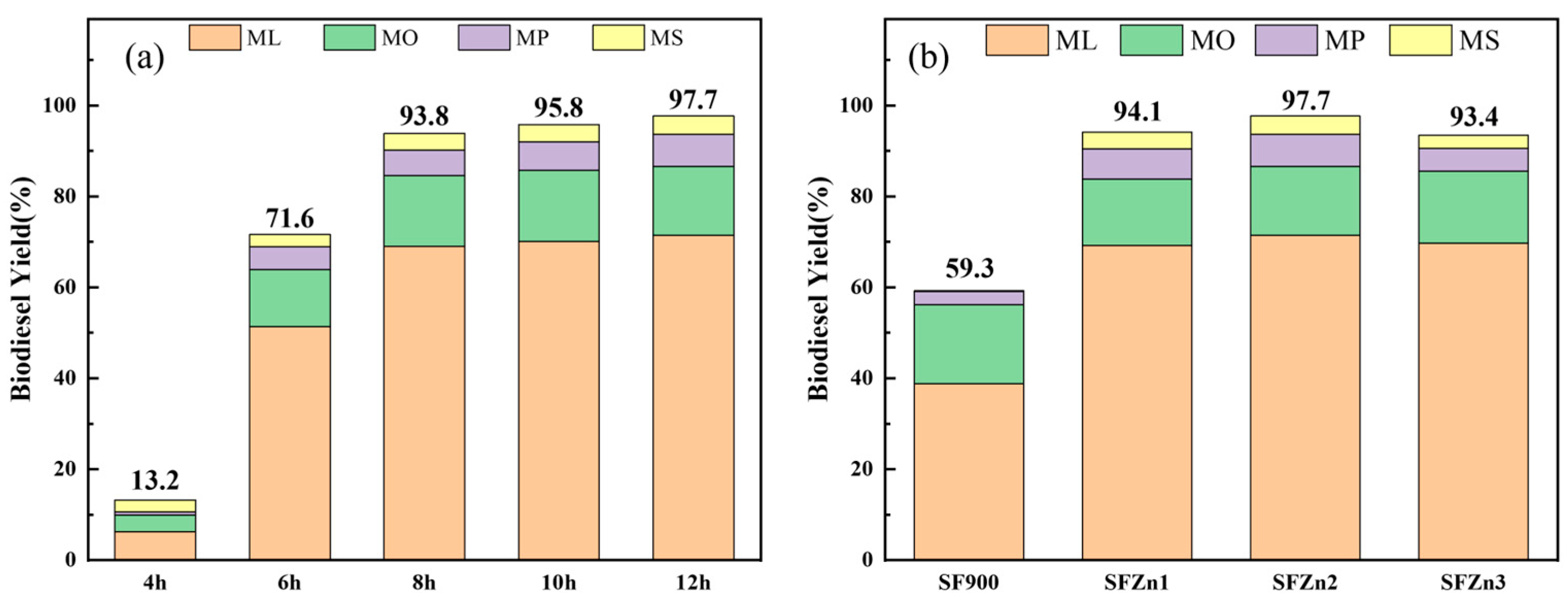
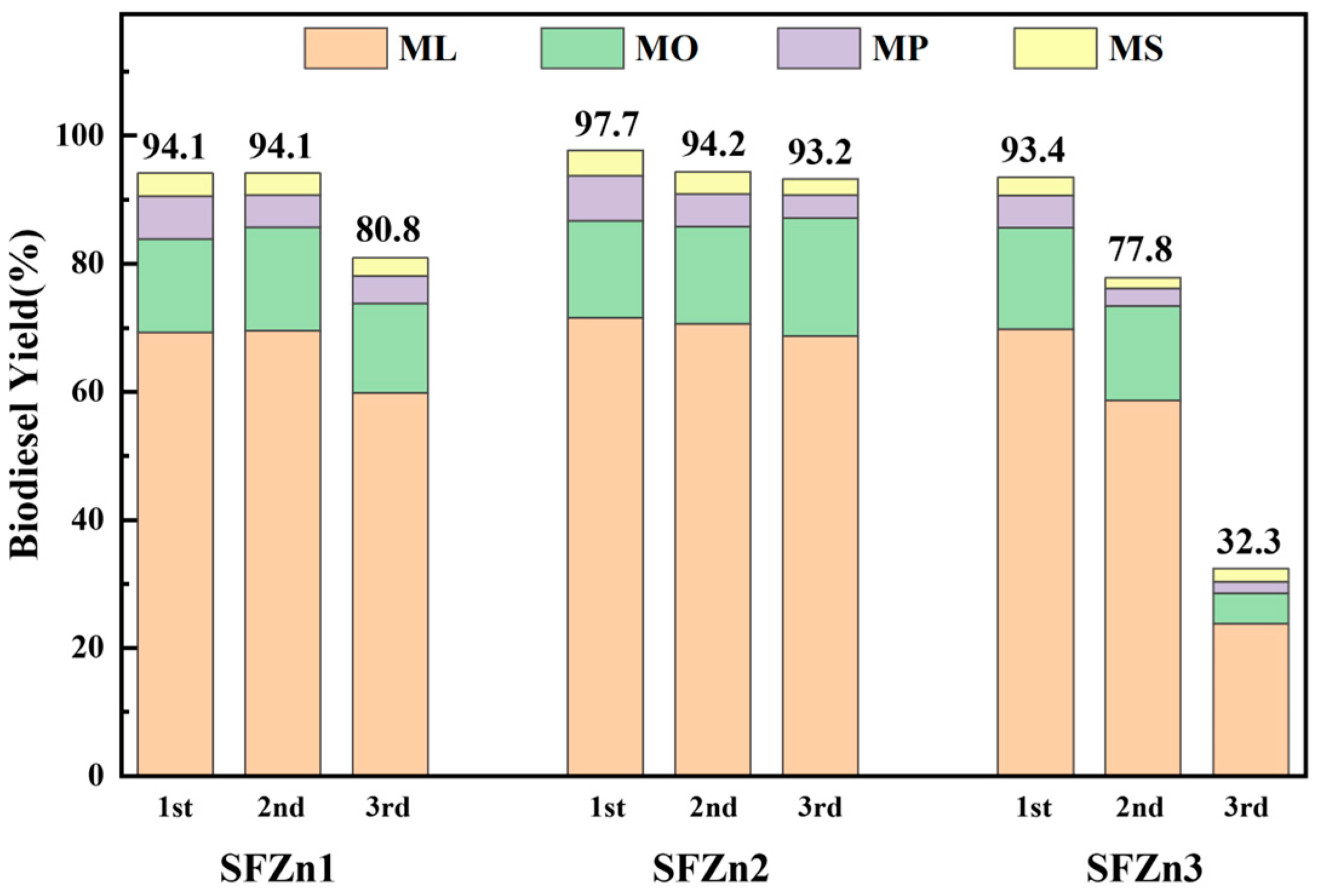
| Linoleic Acid | Oleic Acid | Palmitic Acid | Stearic Acid |
|---|---|---|---|
| 694.55 mg (74.2%) | 139.38 mg (14.8%) | 61.71 mg (7.2%) | 35.69 mg (3.8%) |
| Catalyst | SBET (m2/g) | Vp (cm3/g) | Pore Size (Å) |
|---|---|---|---|
| SF900 | 12 ± 5% | 0.031 ± 5% | 106 ± 5% |
| SFZn1 | 16 ± 5% | 0.032 ± 5% | 81 ± 5% |
| SFZn2 | 29 ± 5% | 0.052 ± 5% | 73 ± 5% |
| SFZn3 | 23 ± 5% | 0.045 ± 5% | 77 ± 5% |
| Catalyst | at. % | wt. % (RSD, %) | ||||
|---|---|---|---|---|---|---|
| Ca | Mg | Zn | Ca | Mg | Zn | |
| SF900 | 91.24 | 8.76 | 0 | 94.50 (0.53) | 5.50 (0.47) | 0 |
| SFZn1 | 79.81 | 13.81 | 6.38 | 80.95 (0.64) | 8.49 (0.51) | 10.56 (0.74) |
| SFZn2 | 70.75 | 14.51 | 14.74 | 68.30 (0.81) | 8.49 (0.85) | 23.21 (0.82) |
| SFZn3 | 51.12 | 22.17 | 26.71 | 47.27 (0.36) | 12.44 (0.44) | 40.29 (0.35) |
| SF900 | SFZn1 | SFZn2 | SFZn3 | |
|---|---|---|---|---|
| Basic strength (mmol/g) | 2.48 | 2.76 | 3.04 | 2.77 |
| Site density (sites/g) | 1.49 × 1021 | 1.66 × 1021 | 1.83 × 1021 | 1.67 × 1021 |
| Catalyst | Yield (%) | Total Yields (%) | |||
|---|---|---|---|---|---|
| Methyl Linoleate | Methyl Oleate | Methyl Palmitate | Methyl Stearate | ||
| SF900 | 38.8 | 17.4 | 2.9 | 0.2 | 59.3 |
| SFZn1 | 69.2 | 14.6 | 6.7 | 3.6 | 94.1 |
| SFZn2 | 71.4 | 15.3 | 7 | 4 | 97.7 |
| SFZn3 | 69.7 | 15.8 | 5 | 2.9 | 93.4 |
| Catalyst | Yield (%) | Total Yields (%) | ||||
|---|---|---|---|---|---|---|
| Methyl Linoleate | Methyl Oleate | Methyl Palmitate | Methyl Stearate | |||
| SFZn1 | 1st run | 69.2 | 14.6 | 6.7 | 3.6 | 94.1 |
| 2nd run | 69.4 | 16.3 | 5 | 3.4 | 94.1 | |
| 3rd run | 59.7 | 14 | 4.3 | 2.8 | 80.8 | |
| SFZn2 | 1st run | 71.4 | 15.3 | 7 | 4 | 97.7 |
| 2nd run | 70.5 | 15.2 | 5.1 | 3.4 | 94.2 | |
| 3rd run | 68.6 | 18.5 | 3.6 | 2.5 | 93.2 | |
| SFZn3 | 1st run | 69.7 | 15.8 | 5 | 2.9 | 93.4 |
| 2nd run | 58.5 | 14.8 | 2.8 | 1.7 | 77.8 | |
| 3rd run | 23.6 | 4.8 | 1.7 | 2.2 | 32.3 | |
Disclaimer/Publisher’s Note: The statements, opinions and data contained in all publications are solely those of the individual author(s) and contributor(s) and not of MDPI and/or the editor(s). MDPI and/or the editor(s) disclaim responsibility for any injury to people or property resulting from any ideas, methods, instructions or products referred to in the content. |
© 2024 by the authors. Licensee MDPI, Basel, Switzerland. This article is an open access article distributed under the terms and conditions of the Creative Commons Attribution (CC BY) license (https://creativecommons.org/licenses/by/4.0/).
Share and Cite
Lee, S.; Ha, J.; Li, O.L. Plasma Modification of Biomass-Based Starfish Catalysts for Efficient Biodiesel Synthesis. Nanomaterials 2024, 14, 1313. https://doi.org/10.3390/nano14151313
Lee S, Ha J, Li OL. Plasma Modification of Biomass-Based Starfish Catalysts for Efficient Biodiesel Synthesis. Nanomaterials. 2024; 14(15):1313. https://doi.org/10.3390/nano14151313
Chicago/Turabian StyleLee, Sungho, Jeyoung Ha, and Oi Lun Li. 2024. "Plasma Modification of Biomass-Based Starfish Catalysts for Efficient Biodiesel Synthesis" Nanomaterials 14, no. 15: 1313. https://doi.org/10.3390/nano14151313






